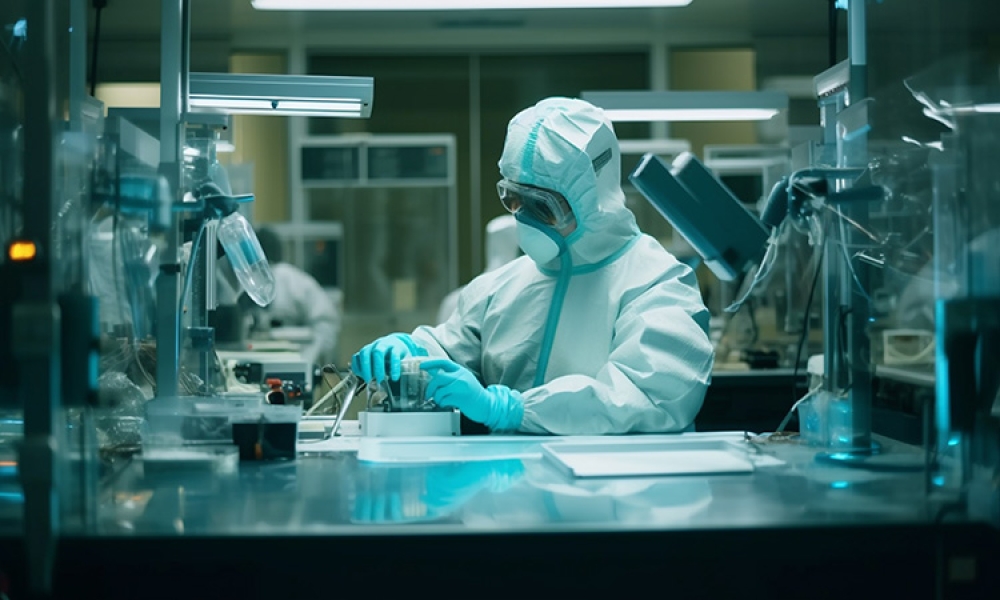Unveiling the Green Prescription: Navigating Sustainability in the Pharmaceutical Industry

Sustainability is emerging as a pivotal force influencing the pharmaceutical industry’s dynamics and steering companies towards transformative change. The focus of this analysis is to delve into the sustainability key performance indicators (KPIs) of prominent pharmaceutical players, namely Pfizer, Sanofi, Glaxo Smith Kline (GSK), Becton Dickinson, Johnson & Johnson, Abbott, Eli Lilly, and Novartis. Through a comprehensive methodology, we have identified and scrutinized fourteen sustainability KPIs, ultimately zeroing in on nine quantifiable indicators supported by numerical data.
Life Sciences Industry Overview
Before we plunge into the sustainability metrics, let's take a snapshot of the global life sciences market. In 2022, the largest market within the pharmaceutical sector was oncology drugs, contributing to 15% of the total market revenue. North America emerged as the powerhouse, with the United States accounting for a staggering $589 billion in the same year. The industry is poised for a steady growth trajectory, with an expected compound annual growth rate (CAGR) of 2.9 percent from 2022 to 2025.
In addition to pharmaceuticals, the medical devices market, dominated by cardiology devices, and consumer healthcare, primarily led by North America, are integral components of the life sciences industry, each with its unique market dynamics and growth forecasts.
Key Sustainability Trends in the Life Sciences Industry
1. Carbon Neutrality Goals
The pharmaceutical and biotechnology sector is sprinting towards carbon neutrality, with 46 percent of companies committing to the United Nations’ Race to Zero campaign. Notably, 53 percent of these companies have initiated the My Green Lab® program in 2022, highlighting a significant uptick from the previous year.1 This underscores the industry's commitment to reducing its carbon footprint through innovative initiatives.
2. ESG Roles
In response to escalating Environmental, Social, and Governance (ESG) commitments, pharmaceutical companies are appointing dedicated ESG strategists and managers. The industry has witnessed an impressive 89 percent growth in new job postings related to ESG since 2020, signifying a paradigm shift towards sustainability-focused roles.
3. Green Chemistry
The adoption of green chemistry procedures is gaining momentum, enabling efficient recycling of solvents, and streamlined manufacturing processes with reduced environmental impact. Continuous flow processes are a game-changer, enhancing energy efficiency and minimizing the overall manufacturing footprint.
4. Sustainable Practices
Pharmaceutical giants are exploring "localized manufacturing" to cut down on the carbon footprint associated with distribution. Additionally, there is a discernible shift towards greener medicines and medical gases, exemplified by innovations in inhalers and anaesthetic gases.
EPA – CO2 Target Setting Recommendations
The Environmental Protection Agency (EPA) provides crucial guidelines for organizations looking to set and report on their greenhouse gas (GHG) reduction targets. Notable companies like Pfizer, BD, and GSK have embraced ambitious targets, aligning with the stringent criteria set by the Science Based Targets initiative (SBTi). These targets go beyond business as usual, necessitating aggressive reductions in emissions.
ISPE Guidelines on Scope 3 GHG Emissions
Understanding and mitigating Scope 3 emissions, generated outside the organization, is a key focus area. The International Society for Pharmaceutical Engineering (ISPE) recommends specific accounting standards for various upstream Scope 3 categories, ranging from chemicals and process materials to transportation and distribution. The emphasis is on engaging with suppliers and internal business choices to holistically address emissions.
WHO – Air Emission Regulations
The World Health Organization (WHO) plays a vital role in shaping guidelines for managing air emissions in pharmaceutical manufacturing. These encompass facility layout, control of air emissions, and operational activities. Ensuring a controlled environment and effective dust, vapor, and fume control are imperative for adherence to WHO standards.
EMA – Quality of Water for Pharmaceutical Use
The European Medicines Agency (EMA) has laid down stringent quality standards for water used in the pharmaceutical manufacturing process. These standards span different grades of water, including potable water, purified water, water for injections (WFI), and their specific applications in the production of sterile and non-sterile medicinal products.
EPA Guidelines on Managing & Reducing Waste Disposal
The EPA provides a roadmap for organizations to enhance waste management, reduce costs, and bolster sustainability. The process involves tracking waste using tools like ENERGY STAR Portfolio Manager®, forming dedicated teams for waste reduction, setting clear goals, and conducting waste assessments or audits.
Trends in Sustainability
1. Net Zero/Carbon Neutrality
Several pharmaceutical companies have committed to achieving net zero emissions within specified timelines. Initiatives include transitioning to renewable energy, recycling materials, and decarbonizing the supply chain. The Energize program, a collaboration between Novartis and global pharmaceutical companies, exemplifies the industry's concerted effort to engage suppliers in bold climate action.
2. Community-based Endowment Programs
Philanthropic endeavours are taking centre stage, with companies launching endowment funds to support vulnerable populations impacted by climate change and pollution. Sanofi's Foundation S, launched in 2022, aims to catalyse community-based solutions across various priority areas.2
3. Waste Management
Efforts to minimize waste generation are underway, with companies adopting sustainable packaging solutions and materials. Abbott's latest continuous glucose monitor, FreeStyle Libre 3, stands out with a 41 percent reduction in plastic use and a 43 percent decrease in carton paper.3
4. Green Chemistry
Pharmaceutical companies are embracing green chemistry to minimize excess products and by-products during manufacturing. Merck's development of a greener method for producing Molnupiravir and Pfizer's substitution of renewable raw materials underscores the industry's commitment to sustainable practices.4
5. Water Stewardship
Recognizing the critical role of water in drug production, companies are investing in wastewater treatment plants equipped with advanced technologies. Novartis's wastewater treatment plant in Romania, utilizing carbon-filter technology, is a testament to the industry's focus on water stewardship.5 .
Pharma KPI Sustainability at a Glance
Let us glance at the key sustainability KPIs that provide a comprehensive overview of the industry's environmental impact, regulatory adherence, and commitment to sustainable practices.
| KPI | Description | Unit | Regulatory View |
|---|---|---|---|
| CO2 Emission | Amount of CO2 emitted by an organization | Scope 1 & 2 CO2 Emission in 2022 (Metric Tons) | EPA Guidelines |
| Air Emission | Direct and indirect forms of air pollution | Volatile organic compounds emission (Tons) | WHO Regulations |
| Water | Amount of water consumption & withdrawal | Water Consumption (Cubic Meter) | EMA Standards |
| Waste | Hazardous/non-hazardous waste material generated | Hazardous waste generated (Tons) | EPA Guidelines |
| Compliance | Number of environmental, health, and safety (EHS) and health, safety, and environmental (HSE) penalties paid | Numbers | GRI Mandates |
| Energy Consumption | Energy consumption from various sources | Energy Consumed (Terajoule) | EPA Recommendations |
| Materials | Product recalls, fatalities, and inspections | FDA Product Recalls | FDA Guidelines |
| Sustainable Medicine | Programs in development focusing on innovative design | New Molecular Entity (NME)/Vaccines Programs | FDA Regulations |
| Workforce Health | Metrics like reportable injuries | Lost Time Injury Frequency Rate | WHO Standards |
Sustainability Use Cases Specific to the Manufacturing Environment
In the pursuit of sustainability, pharmaceutical companies are adopting a myriad of strategies within their manufacturing processes. From eliminating steam loss to optimizing chiller plants, embracing energy-efficient HVAC systems, and incorporating green chemistry practices, the industry is at the forefront of innovative solutions. Employee training, efficient water usage, and waste reduction are integral components of these sustainability use cases.
Conclusion
In conclusion, the pharmaceutical industry is at a crossroads, navigating the complex terrain of sustainability. The adoption of stringent KPIs, adherence to global guidelines, and the implementation of innovative sustainability initiatives underscore the industry's commitment to a greener and more responsible future. As pharmaceutical giants forge ahead, the green prescription becomes a guiding ethos for a healthier planet and a thriving industry.
- 1Millar, Stephanie, and James Connelly. "Almost Half of the Pharma and Biotech Sector Has Joined the Race to Zero. Here’s why It Must Go Further." Race to Resilience: Race to Zero. United Nations Framework Convention on Climate Change, November 11, 2022. https://climatechampions.unfccc.int/almost-half-of-the-pharma-and-biotech-sector-has-joined-the-race-to-zero-heres-why-it-must-go-further/.
- 2"Foundation S: Creating Healthier Futures for Generations to Come." Sanofi. https://www.sanofi.com/en/our-company/social-impact/access-to-healthcare/foundation-s.
- 3"FreeStyle Libre 3: World's Smallest Sensor Is Here." Abbott. September 28, 2020. https://www.abbott.com/corpnewsroom/strategy-and-strength/freeStyle-libre-3-worlds-smallest-sensor-is-here.html.
- 4"Green Chemistry Challenge Winners." EPA. https://www.epa.gov/greenchemistry/green-chemistry-challenge-winners.
- 5"Water." Novartis. https://www.novartis.com/esg/environmental-sustainability/water.



